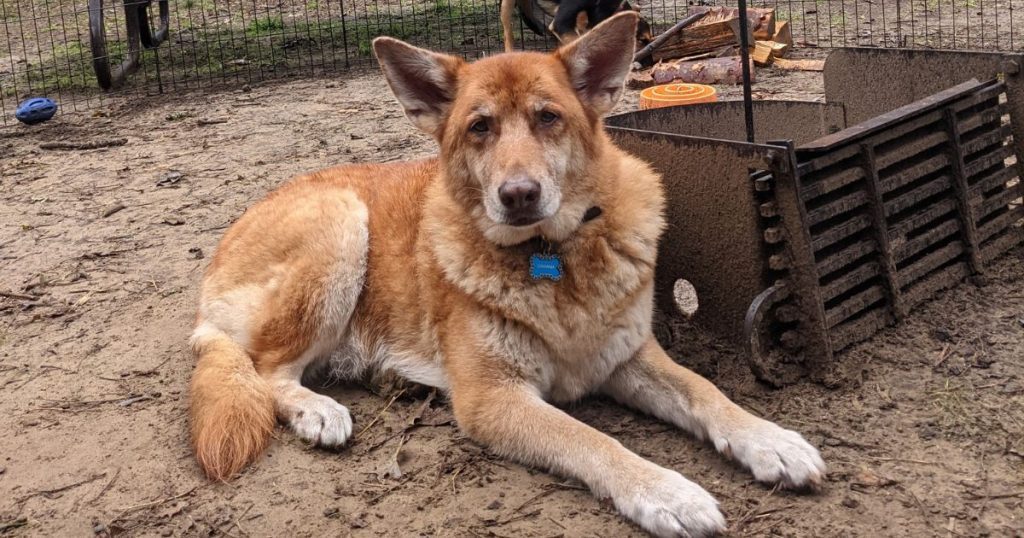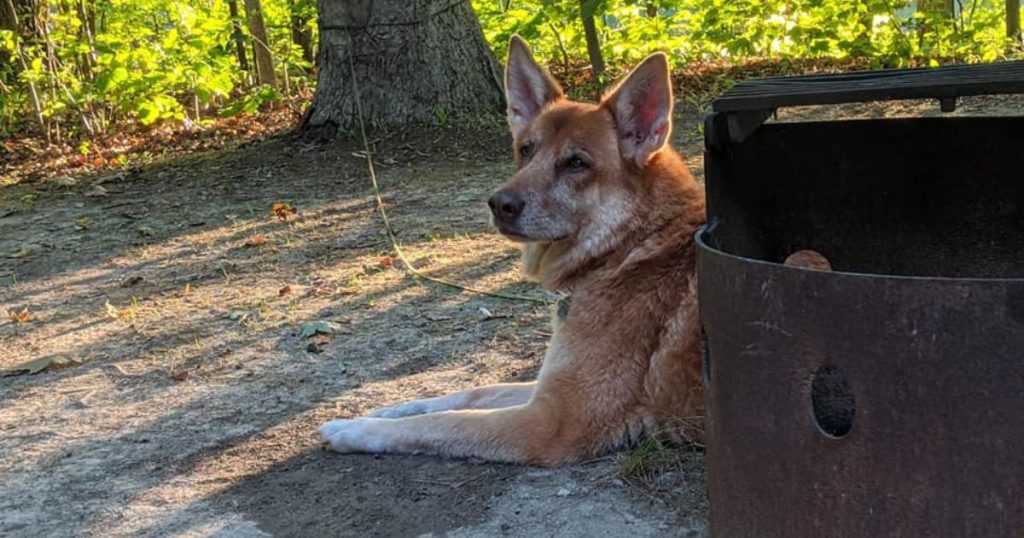Tips for Outdoor Travel with a Senior Pet
There is something truly special about sharing your heart with a senior pet. They have given years of love, loyalty, and dedication.
Even if they join your family later in life, the love from an older pet is so special and unique.
If you are like us, you love outdoor travel and can’t imagine travelling without your pets by your side. But can you travel with a senior pet safely?
Yes! Many pet parents have found ways to include their senior cat or dog in their travel plans.
Of our five pets, four are now officially considered to be seniors. While we have had to change our plans a little to accommodate their needs, we don’t have to leave anyone at home.
Even our 15-year-old German Shepherd mix, Daviana, regularly hikes and camps with us.
How do we do it? The following tips and tricks allow us to travel with our senior pets while prioritizing their safety and comfort.

This post contains affiliate links, which means if you click and buy, we will make a commission (at no cost to you). See my full disclosure policy for more details.
Is it Safe to Travel with a Senior Dog or Cat?
As our pets age, they become a little more vulnerable. Therefore, the most important thing to consider when travelling with a senior dog or cat is their safety and well-being.
Before booking any upcoming adventures, make an appointment with your veterinarian.
This is the perfect opportunity for you to ask any questions that are on your mind. They will also be able to warn you about any restrictions you will need to work around with your pet.
For example, if you have a senior dog with mobility issues, they may be unable to do a longer hike. A less physical activity like canoeing could be a better option.
Never push your pet to do more than they can do safely. If you have your heart set on an adventure that has the potential to be too much, consider leaving your senior pet with a trusted friend, family member, or pet sitter.
Can Senior Dogs Go Hiking?
There is no black-and-white answer to this. Whether your senior dog can safely go hiking will depend on their health and mobility. This will vary from dog to dog.
We are blessed that while she has slowed down slightly, Daviana is still in great shape for her age.
She can no longer tackle some of the more challenging trails from our past. But she loves heading out with us on the easy-to-moderate trails. This is a great way to keep her active.
If you’re unsure about your dog’s ability to complete a trail, ensure you are prepared to carry them out. The gear needed will depend on your dog’s size ranging from dog backpacks for smaller breeds to an emergency dog carrying harness for larger pups.
How Old is Too Old for a Senior Pet to Travel?
The truth is that no set age makes a pet too old to travel. Instead, there are many factors to consider when deciding whether your pet is still up to the adventure lifestyle.
This includes:
- Breed/size (larger dogs age faster than cats and small dogs)
- Any health issues or mobility concerns
- Pet’s lifestyle (are they regularly active?)
- What your travel plans involve
- Your ability to accommodate your pet’s needs
If you are unsure, discuss your concerns with your veterinarian. They can help you make an informed decision with your pet’s best interests in mind.

Tips and Tricks for Comfortable Travel with a Senior Pet
Consider Mobility Supplements
One way to prepare for travel with a senior pet today is to investigate the available supplements designed for improved mobility.
While supplements won’t reverse any joint damage your dog may have suffered, they can help to prevent future damage while relieving any discomfort they are experiencing.
Some supplement options that could be beneficial to your senior pet include:
- Omega-3 fatty acids
- Glucosamine
- Chondroitin
- Green-lipped mussels
- Fish oils
You can purchase a complete vitamin and supplement product that addresses multiple aspects of your dog’s health or choose something joint and mobility specific. We recommend more specific options to target the problem best.
Help Your Pet In and Out of the Vehicle/Trailer
When bringing your pet along on your outdoor travels, there is more to think about than just the camping experience. You must also consider how to safely road trip with a senior dog or cat.
This includes keeping your pet safely contained during travel and allowing them to get in and out of the vehicle safely.
Senior dogs can easily injure themselves by jumping out of a vehicle onto the hard ground below. Instead, consider using pet stairs or a safety ramp to provide them with a safe exit path.
If you are travelling with a senior cat or smaller dog, be prepared to lift them out of the vehicle.
These items can also be used to allow your pet to safely move in and out of the trailer if you are staying in a travel trailer or RV. The stairs on many trailers aren’t suitable for a pet with mobility issues.
Scope Out the Campsite for Mobility Concerns
When you first arrive at your campsite, walk around the space. Look for any tripping hazards or uneven areas that could lead to an injury.
Before you set up, clear any objects like large rocks or branches that can be moved from the campsite area. Try to avoid any areas of concern when setting up your pet’s space.
Pack a Comfortable Bed Option
Your pet’s bed is essential when trying to keep them comfortable in their golden years. A good bed will offer a comfortable place for your pet to sleep while providing much-needed support.
Consider an elevated bed for dogs and cats that struggle to get down onto the ground to use a standard bed.
Orthopedic beds are made with memory foam for optimal support. The bed will contour your dog’s body, taking pressure off their aching joints after a long day at camp.
You can pair your dog’s bed with a cooling blanket in the summer or a cozy self-heating blanket during the cooler season for added comfort.

Be Reasonable with Activity Plans
Consider your pet’s limits when making plans for your next trip. They may not be up to all the activities and adventures they enjoyed when they were younger.
This could mean opting for easier or shorter trails, limiting the number of activities you plan during a single trip, or scheduling your day to allow plenty of downtime between activities.
Alternatively, you could make changes to your activities to accommodate your senior pet’s needs. Some ways you can do this include the following:
- Bike the local trails with a bike trailer for your pet
- Carry small to medium-sized pets using a backpack
- Swimming is a great low-impact activity for water-loving pets
- Canoeing and kayaking are zero effort for furry passengers
- Try stationary activities like fishing
Of course, if you enjoy camping, you can also opt to enjoy spending time at the campsite while your senior pet relaxes. Who doesn’t love hanging out around the campfire?
Pay Attention to the Weather
When planning to travel with a senior pet, pay careful attention to the forecasted temperatures.
Senior pets are more vulnerable to extreme temperatures, both hot and cold. This means your pet is at higher risk for serious health complications like heat exhaustion, heat stroke, dehydration, and hypothermia.
Consider planning your trips for times when the temperatures are more forgiving, or pack gear to help keep them safe and comfortable.
Plan for Lots of Breaks
If you are hitting the trails, take plenty of breaks along the way. Allow your pet to sit or lay down for a moment, and offer fresh water to keep them hydrated.
This will impact the time needed to complete your favourite trails, so plan accordingly.
Bring Extra Cleanup Supplies
As our pets enter their golden years, they may start making “messes” that they didn’t when they were younger.
These messes come in many different forms. If your pet’s eyesight is starting to go, they may struggle to see their food while eating, causing them to spill or get food on their face.
Senior pets may also experience more “accidents.” They may be suffering from incontinence or simply don’t always realize that they need to go until it’s too late.
Don’t let these little mishaps ruin your trip or prevent you from including them in your adventure plans. Bring the supplies needed to quickly clean up when needed, eliminating any stress and freeing you both up to enjoy the rest of your time together.
Be Prepared for Emergencies
This final point isn’t unique to travelling with a senior pet. Anytime you travel with a pet, regardless of age, you should be prepared for any emergencies that may happen.
Before heading out to the campsite, take some time to research the veterinarians and emergency hospitals in the area.
Write down the address and phone number for each location and keep this information somewhere easily accessible. On car camping trips, we keep this information tucked in the visor of the passenger seat so that I can quickly grab it while we are already starting to drive in an emergency.
Pack a pet-friendly first aid kit with your gear. Check it regularly and restock your supplies as needed.

Do you travel with a senior pet? In what ways have your travel plans changed or evolved as your pet aged? Let us know in the comments!
